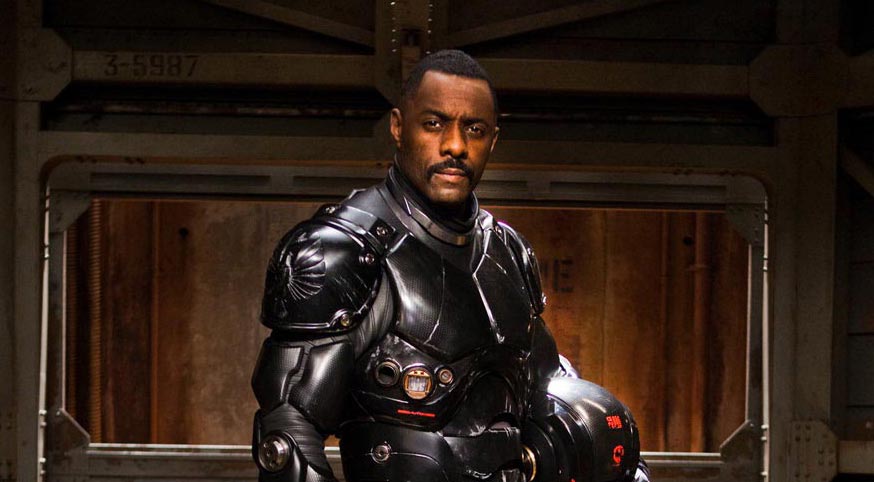By Armond White
After Zack Snyder‘s Man of Steel brought visual ingenuity, emotion and moral gravity to the sci-fi spectacular, it’s hard to settle for over-the-top childishness like Pacific Rim. Director Guillermo del Toro favors frivolous exaggeration–the world under attack by Kaiju, gargantuan sea monsters. Mankind fights back by building Jaegers, 25-story tall robots controlled by two-person teams psychologically linked in what‘s called “The Drift.”
 “The Drift” might have been a better title since Pacific Rim moves aimlessly away from intelligence in favor of true, fanboy nerdism. Del Toro shows no taste for the intricacies of conscience and ethics that distinguished Man of Steel; his Jaeger-drivers Raleigh (Charlie Hunnam) and Mako (Rinko Kikuchi) and military Commander Stacker Pentecost (Idris Elba) are not characters but puppeteer action-figures. Del Toro could be accused of contriving past sci-fi formulas–from Avatar, Real Steel, Iron Man, Transformers–but Pacific Rim is essentially dumb and hokey. It’s an oversized homage to Godzilla and Rodan movies, essentially an instant replay of their slow-moving battles but with modern, 3D, CGI pizzazz.
“The Drift” might have been a better title since Pacific Rim moves aimlessly away from intelligence in favor of true, fanboy nerdism. Del Toro shows no taste for the intricacies of conscience and ethics that distinguished Man of Steel; his Jaeger-drivers Raleigh (Charlie Hunnam) and Mako (Rinko Kikuchi) and military Commander Stacker Pentecost (Idris Elba) are not characters but puppeteer action-figures. Del Toro could be accused of contriving past sci-fi formulas–from Avatar, Real Steel, Iron Man, Transformers–but Pacific Rim is essentially dumb and hokey. It’s an oversized homage to Godzilla and Rodan movies, essentially an instant replay of their slow-moving battles but with modern, 3D, CGI pizzazz.
Childish, undemanding audiences will be satisfied but when it comes to the toy-like effect of movies, is mere satisfaction really enough? Del Toro’s fascination with sci-fi gimmickry results in a film cluttered with too much machinery. (And it teases sub-Nolan nihilism when a fighter is challenged: “Haven’t you heard the world is coming to an end? So where would you rather die? Here or in a Jaeger?”) Del Toro’s homage lacks the simplicity of Ray Harryhausen special effects that were enjoyable for their hand-made creativity. These Kaiju and Jaegers look too digital, like Jeff Koons creations when all you need is a kite, a toy soldier, a video game or a mylar balloon.
That cleverly ramshackle 1998 Beastie Boys video Intergalactic, directed by Adam Yauch, delightfully evoked 60s Japanese monster flicks, TV shows and boyish imagination and gave sweeter thrill. This childish vision, like Peter Jackson’s in Lord of the Rings, is so overwrought it becomes tiresome and petty. Del Toro needs some Joe Dante humor in him (cutting to desk toy isn’t it, especially not after Soundwave in Transformers: Dark of the Moon). Del Toro’s best moment is only half-great: when Raleigh drifts into Mako’s dream and the evocation of WWII American-Japanese relations, the ambivalent panic and sexual security, almost becomes a theme. Nothing in Del Toro’s cruel, dull Pan’s Labyrinth was as resonant.
Pacific Rim’s dumbest parts offer Del Toro’s usual predictable dread: A Kaiju that morphs from reptile to bat to demon and a climactic fight revealing another Del Toro vision of subterranean hell. He’s still seeking an audience of hellboys. At least his cast deserves better. They’re affecting performers: Hunnam recalls Depardieu’s physical charm, Kikuchi’s anxiety connotes the history of a fleeing populace from Japanese monster movies and Elba updates stalwart conviction–he gets a post-9/11 St. Crispin’s Day speech. (“Today, at the edge of our hope, at the end of our time, we’ve chosen to believe in each other. Today, we are cancelling the apocalypse.”) But Del Toro omits the saintliness, unlike Man of Steel, which leaves an appealing, if less than super, heroic trio.
Follow Armond White on Twitter at 3xchair
